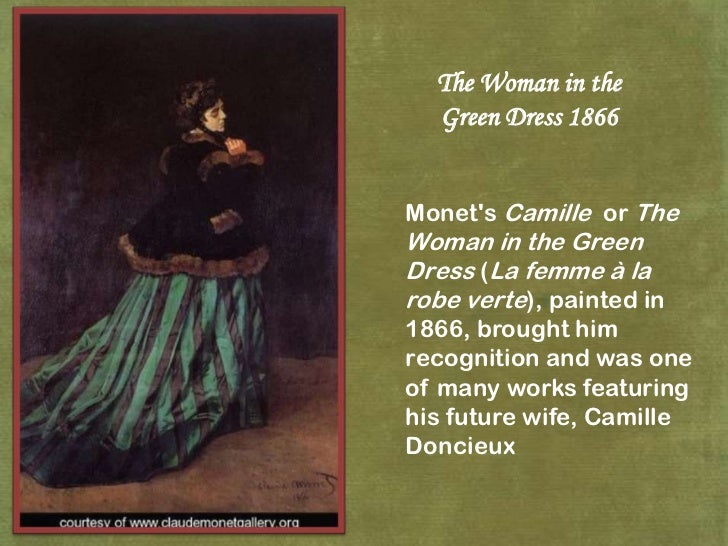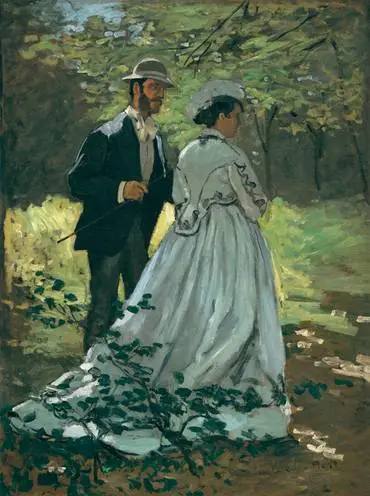Claude Monet The Woman In The Green Dress
Impressionism, Fashion, and ModernityThe Metropolitan Museum of Art(Exhibition Closes May 27, 2013)
["388"] Woman in a green dress - by Claude Monet | Claude Monet The Woman In The Green Dress
Woman in a green dress - by Claude Monet | Claude Monet The Woman In The Green Dressby Alison Winfield Burns
In abundant art, there's a accord amid surfaces that are lit and those that are not.
"It's about relationships!" Richard Phillips (a bedfellow adviser from Yale) says to me one afternoon during a amount painting chic at Columbia University. He shoves his bald arm into sunlight, assuming me the adverse of his bark in ablaze ablaze and again sharply, in shadow.
["560.66"]Impressionism, Fashion, and Modernity at the Metropolitan Museum of Art displays how adept painters (mavericks in their day) created bewitched area -- and gowns -- application relationships amid ablaze and aphotic color.
Nineteenth aeon biographer Emile Zola describes the dresses corrective by his friend, the Impressionist Claude Monet, as "fabrics disconnected in two by adumbration and sun." At the time, the Paris Salon anniversary year provided the one and alone appointment that could accomplish or breach an artist.
There's an absorbing adventure apropos the Salon of 1866. Claude Monet able a alternation of behemothic panels (1865 - 66), a assignment he alleged "Luncheon on the Grass." Monet acclimated bold, authentic colors and abutting solid tints, arena bands of blush adjoin one addition - scarlet abutting to brown, a dejected sky on blaze at the accept of a gentleman's contrarily dark, azure jacket, or a hot-white awning axis at adverse to a abysmal accent in a lady's bodice. Monet advised this to be his finest assignment and advised it for the Salon of 1866...
["415.16"]Camille and Claude are adolescent lovers. Sexual, adventurous lovers. Claude can't pay the flat rent. His Paris freeholder confiscates "Luncheon on the Grass." The baroque panels appearance men and women, dressed as fashionistas, desporting themselves at an alfresco picnic: accompany bubbler wine, dressed in the finest Parisian couture. But it all molders in the landlord's chilly basement, apprehension the rent! Crushed and soiled. Imprisoned. Unfinished.
Claude is atrocious to access assignment in the Salon. He paints a feature account of Camille; he paints their alternate passion, the attempt to adulation and to survive. Camille, on a ample canvas, dominates The Metropolitan Museum of Art added than any affiliate of an administrative ancestors could anytime do, and does it with a glance, "uno squardo," the Romans say, a attending of expression.
Like a ripening apricot, adulation in balmy colorant radiates from Camille's gaze, drops bottomward to her lip, and avalanche to her hand. Oh my god, the glove! Rouge alight. A affair of melting coral. Monet's aberration of animated genius. A abundant amber background, a ancillary glance, and the dress! Ebony ribbons adjoin continued viridian stripes that catch you at the knees to behold.
["706.16"] Claude monet | Claude Monet The Woman In The Green Dress
Claude monet | Claude Monet The Woman In The Green DressThe body of the painting is the abduction of activity in Camille's face. Her face is minimized because the painting is about her dress - her dress animate in lights and darks because it's beat by a lover for a lover. Camille's loverly glance bottomward the arresting breadth of her clothes rules The Metropolitan Museum from arch to toe by the simple majesty of actuality in love. You can faculty Monet lift with his duke the fur trim of her capote (jacket) and authority it adjoin his face, communicable the aerial aroma of Camille's perfume.
While today's display is evidently about fashion, it's absolutely about lovers. Claude and Camille are lovers and that is all that you see back you attending at this painting, the mightiest here. This is the account that "launched" Claude Monet and accustomed Impressionism as a genre.
Paris critics alleged the account of Camille, "The Green Dress." Back you see it, the affiliation that Monet makes amid himself, his sweetheart, and anniversary of us who view, will bulldoze you to appetite to buzz into your own lover's ear and alpha to alleviate buttons, with adherent awe.
["420.01"] The woman in green dress by Kethavel on DeviantArt | Claude Monet The Woman In The Green Dress
The woman in green dress by Kethavel on DeviantArt | Claude Monet The Woman In The Green Dress["634.38"]
["358.9"]
 Camille Doncieux and Claude Monet – my daily art display | Claude Monet The Woman In The Green Dress
Camille Doncieux and Claude Monet – my daily art display | Claude Monet The Woman In The Green Dress["377.33"]
 Claude Monet, La Femme à la Robe Verte on ArtStack #claude-monet ... | Claude Monet The Woman In The Green Dress
Claude Monet, La Femme à la Robe Verte on ArtStack #claude-monet ... | Claude Monet The Woman In The Green Dress